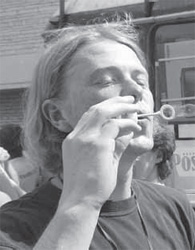|
|
Estland | Estonia
Mitten in der Pubertät

Mit fünf Premieren abendfüllender Spielfilme war 2005 ein ungewöhnlich produktives Jahr für das estnische Kino. Die Palette ist bunt gemischt: der Kassenerfolg des Kinderfilms „Der magische Kater“ von Rene Vilbre, die unter der Ägide des Meisters Priit Pärn entstandene, politisch unkorrekte Animation „Frank & Wendy“, die Tragikomödie „Shop of Dreams“ von Peeter Urbla, das Monty-Python- artige Spott-Epos „Men at Arms“ von der Rebellentruppe Õ-Fraktsioon und nicht zuletzt eine estnisch-deutsche Co-Produktion: „Fed up! / Schnauze voll!“ des regelmäßigen Berlinale-Teilnehmers Peeter Simm. Nach 14 Jahren Souveränität und einem Jahr Mitgliedschaft in der EU steckt die Filmproduktion Estlands mitten in der Pubertät – mit allem, was dazu gehört: die eifrige Suche nach Identität, Wachstumsschmerzen und vor allem eine Menge Aufregung. Wir sind Zeugen der Entstehung einer ausgeprägten und selbstbewussten Filmkultur.
Für ein Land mit 1,4 Millionen Einwohnern scheint das derzeitige Produktionsniveau an Filmen fast – aber auch nur fast – ein vernünftiges Maß zu erreichen: drei bis vier Spielfilme, sechs bis acht Animationen und 30 Dokumentarfilme pro Jahr. Das reicht immer noch nicht an die fünf Spielfilme heran, die als Voraussetzung für das Funktionieren einer Filmindustrie gelten. Dennoch ist die Filmförderung in den vergangenen drei Jahren um ein Drittel gestiegen und erreicht in diesem Jahr 4 Millionen Euro. Als nächstes gilt es, die Fernsehanstalten in die Filmförderung einzubeziehen. Ein Vertrag zwischen dem öffentlich-rechtlichen Sender ETV und der Estonian Film Foundation wird voraussichtlich noch vor den diesjährigen Nordischen Filmtagen unterzeichnet.
Estland ist vielleicht die am meisten international ausgerichtete Filmkultur Europas, da nahezu alle estnischen Spielfilme und fast die Hälfte aller Dokumentationen in internationalen Co-Produktionen entstehen. Filmemacher aus Estland mischen auf der internationalen Bühne mit – ebenso wie ihre Filme, die im vergangenen Jahr auf Festivals in über 40 Ländern gezeigt wurden. Ab Herbst 2006 wird es in Tallinn die Baltic Film and Media School geben. Die vollständig digital ausgestattete Ausbildungsstätte wird eine Film- und eine Medienabteilung unterhalten sowie Studierende aus der gesamten baltischen Region aufnehmen. Dies wird sicher einen großen Einfluss auf die Zukunft des estnischen und auch des baltischen Kinos haben. Hoffentlich werden die ersten Früchte möglichst bald bei den Nordischen Filmtagen in Lübeck zu sehen sein.
Martin Aadamsoo
Geschäftsführer Estonian Film Foundation
Prime of Teens
The year 2005 has been unusually productive for Estonian cinema with five new full-length features premiering at local cinemas. The palette is motley, including the box office smash for children “Mat the Cat” by debutant Rene Vilbre, the politically incorrect animation “Frank & Wendy” hatched under the aegis of master Priit Pärn, a contemporary dramedy “Shop of Dreams” by mainstay Peeter Urbla, a Monty Pythonesque mock epic “Men at Arms” by the rebel crew Õ- Fraktsioon, and last not least an Estonian- German co-production “Fed up! / Schnauze voll!” by the Berlinale regular Peeter Simm.
It appears that 14 years after regaining sovereignty and one after joining the European Union, independent Estonian filmmaking is in the prime of its teens with all that comes with it: an eager search for identity, development pains and, above all, much excitement. We are witnessing the emergence of a
distinct and self-confident movie culture in progress.
For a country of 1.4 million people, Estonia’s current yearly production levels seem almost (but just almost!) reasonably measured, with 3 - 4 features, 6 - 8 animations and 30 documentaries produced annually. This is still short of the regular five full-length films considered necessary to keep a professional film industry marching. However, national film financing has grown by a third over the last three years and reaches 4 million euros in 2005, certainly a step in the right direction. The next step is to involve TV stations in film financing, and a breakthrough contract between the public broadcaster ETV and Estonian Film Foundation to this effect is likely to be signed by this year’s Lübeck Film Days.
Estonia is probably one of the most internationally minded film cultures in Europe, with almost all Estonian features and nearly half of the documentaries made in international co-production. This is as much due to deliberate choice as to financial and technological necessities. One way or the other, Estonian filmmakers are very much on the international circuit, as are Estonian films, shown at festivals in over 40 countries last year.
From the autumn of 2006, Estonia will host the Baltic Film and Media School in Tallinn. The fully digital new school will include a film and a media/communications division and admit the first international students from the whole Baltic region. This may be the single strongest influence on the long-term future of Estonian, and perhaps Baltic, cinema. Let’s hope its first fruits will be on display at Lübeck’s Nordic Film Days some time in the near future.
Martin Aadamsoo
Managing Director Estonian Film Foundation
|



